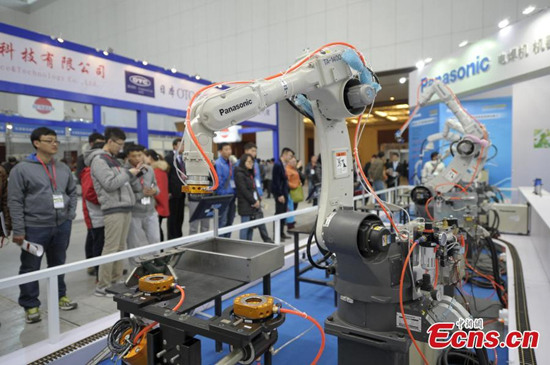
Visitors look intelligent robot demonstrating operation at the 11th China (Tianjin) International Equipment and Manufacturing Expo in Tianjin, March 12, 2015. The expo, covers an area of 80,000 square meters, is the largest robot show in China. China is now the world's largest industrial robot market with over 30 robot factories under construction, Xinhua reported in 2014. (Photo: China News Service/Tong Yu)
In the southern Chinese city Dongguan, a precision mold processing plant is replacing nearly 2,000 workers with 1,000 robotic arms.
One of biggest production cities in Guangdong province, Dongguan is experiencing a harsh labor shortage, with about 100,000 workers needed for the region.
As a result, automated factories are seeing a surge of popularity.
Dongguan's first "robot factory", owned by Evenwin Precision Technology Company, just shut down a staff dormitory ahead of the arrival of imported robots at the beginning of May.
About 100 robotic arms have already been put into service at the company's factory, while another 900 are being installed and debugged.
"Assembly line workers used to run computer numerical control (CNC) machines, which bred potential safety hazards and disturbed quality stability," said Ren Xiangsheng, executive manager of the company.
Ren said less than 200 workers are needed to operate and maintain the robotic arms which can achieve the same output that used to require more than 2,000 workers.
LABOR DRAIN
Development in Guangdong -- and the rest of China -- used to rely heavily on labor intensive manufacturing, and cheap labor is the key in attracting foreign investment. But the story has changed as the working-age population -- those aged from 15 to 59 -- is declining.
According to the National Bureau of Statistics (NBS), the population of the age group first showed a decline by the end of 2012, with 3.45 million fewer than the previous year. The year 2013 witnessed another decline of 2.27 million.
Ma Jiantang, former head of the NBS, said the declining trend in labor population will continue until 2030.
Labor costs are growing by 20 percent a year amid a dwindling influx of migrant workers, said Qu Suoling, chairman of the association of Taiwan-funded enterprises in Dongguan.
"The number of migrant workers looking for jobs this year is down by at least 20 percent," said an HR manager of a factory in Houjie Township, Dongguan City.
Strikes calling for better pay and welfare also break out occasionally.
















































